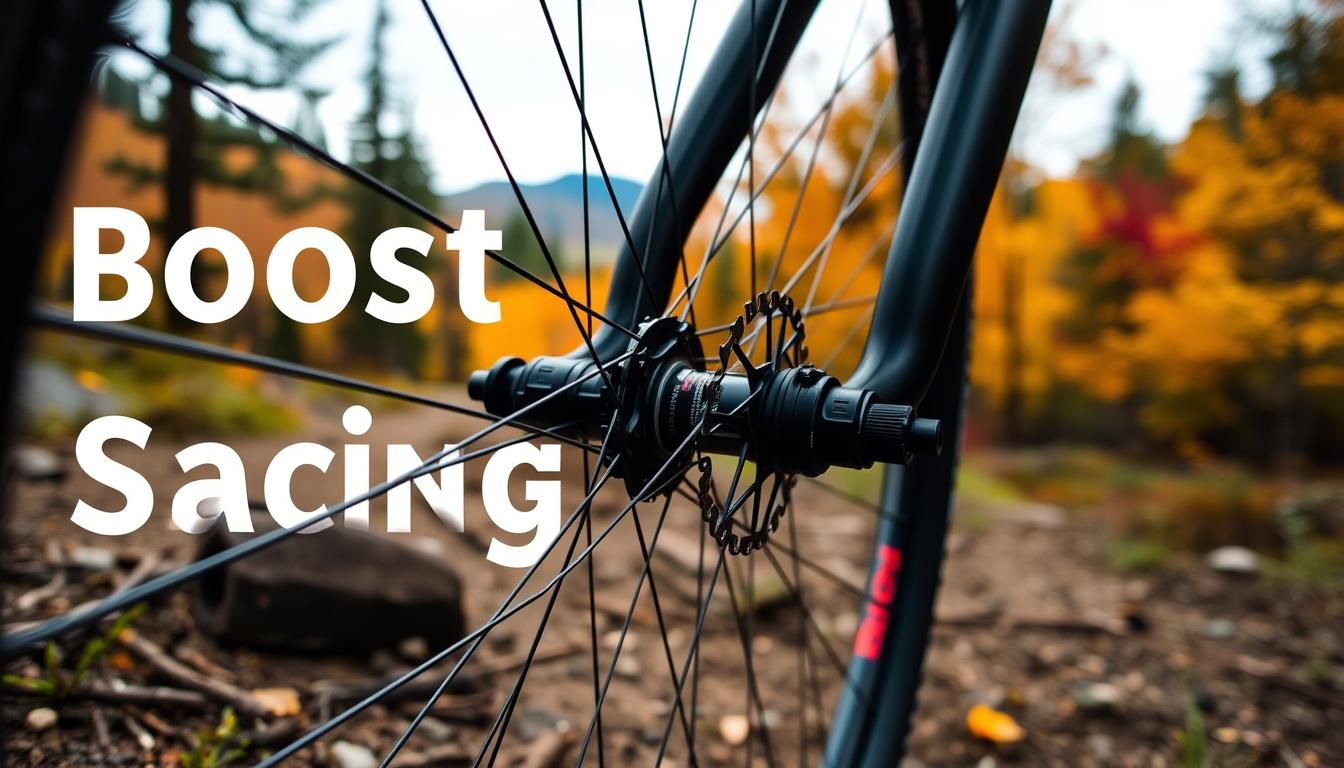The Chromag Lowdown bike is a top choice for mountain biking. It has boost spacing, making the ride stable and confident. Boost spacing is a key feature that improves the ride.
The bike’s frame is designed with boost spacing in mind. This means the hubs are farther apart. This design boosts the bike’s stability and performance.
The Chromag Lowdown bike has 148mm Boost spacing. It also has a Rock Shox ZEB Ultimate fork and Super Deluxe Ultimate shock. These components work together for a smooth ride.
Knowing about boost spacing is important for mountain bikers. It helps them get the most out of their ride.
For more on bike frame boost spacing, the Chromag Lowdown bike is a good example. Its design and components show how boost spacing can improve the ride. The bike’s frame is made of 4130 Cr-Mo Steel and 6066 Aluminum.
Key Takeaways
- Boost spacing is a feature in mountain bikes that can enhance the ride.
- The Chromag Lowdown bike features 148mm Boost spacing, which provides a stable and confident ride.
- Understanding what is boost spacing mtb and how it affects the bike’s performance is crucial for mountain bikers.
- Bike frame boost spacing is a critical aspect of the bike’s design.
- Mtb boost spacing explained simply refers to the increased spacing between the hubs, which can improve the bike’s stability and performance.
What is Boost Spacing MTB: A Comprehensive Introduction
Boost spacing has changed mountain biking, offering many benefits to riders. It’s key to understand what boost spacing is, how it came to be, and why it’s useful. Simply put, mtb boost spacing explained is a way to make wheels stiffer and last longer.
The need for better riding and frame design led to boost spacing. It brings boost spacing advantages like stiffer wheels and wider pivots. This makes riding more stable and efficient. Plus, it works well with many parts, like forks and wheels, making it a favorite among bikers.
Basic Definition of Boost Spacing
Boost spacing means hubs are wider, making wheels stiffer and rides better. For example, Boost 148 adds 3mm on each side, making the total spacing 6mm wider.
Historical Development of MTB Hub Standards
MTB hub standards have changed a lot over time. Boost 110 and Boost 148 hubs are now common, showing a big change. More and more makers are using these standards, hinting at future changes.
Why Boost Spacing Was Developed
Boost spacing was made to improve riding and frame design. It makes wheels stiffer and more durable. It also makes rides more efficient and frames better. With wider pivots and more chainring options, it’s a hit among bikers. Many makers now include it in their products.
| Hub Standard | Width | Flange Spacing |
|---|---|---|
| Boost 148 | 148mm | 3mm increase on each side |
| Boost 110 | 110mm | 5mm increase on each side |
Understanding Hub Spacing Measurements
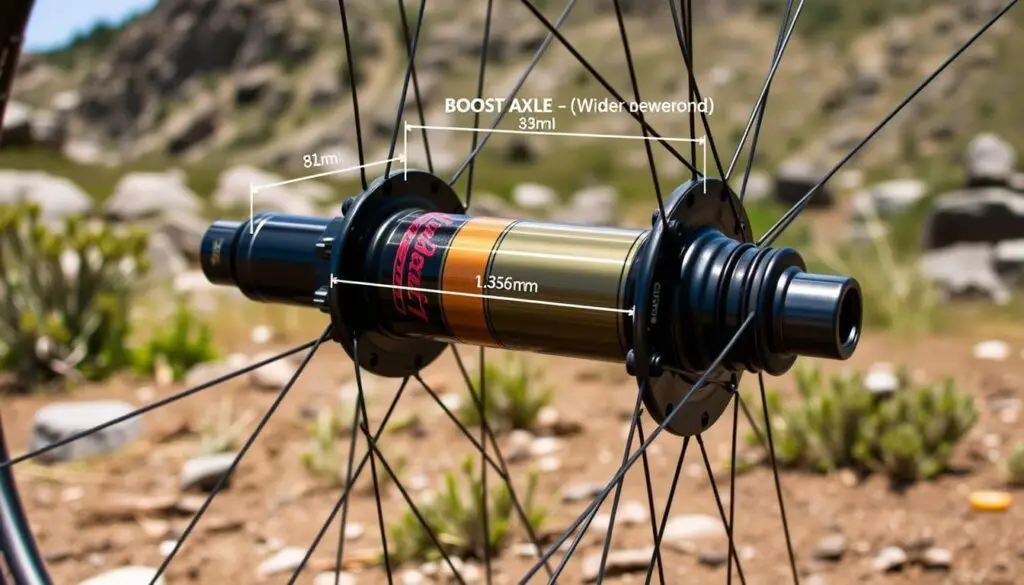
When it comes to mtb hub boost spacing, measurements are key. They affect a mountain bike’s performance. For example, the Chromag Lowdown bike has a 148mm boost spacing. This makes for a stable and confident ride.
Traditional mountain bikes use 9mm front and 10mm rear axles. But, modern bikes have 15x110mm front and 12x148mm rear boost thru-axles. These changes improve stiffness and tire clearance.
- Front hub spacing: 100mm, 110mm, or 15x110mm for boost spacing
- Rear hub spacing: 135mm, 142mm, or 12x148mm for boost spacing
- Super Boost rear axles: 157mm, adding 9mm to the traditional boost spacing
Knowing these measurements is crucial for mountain bikers. They can greatly affect a bike’s performance and handling. By understanding boost spacing, riders can fine-tune their bike for a more stable ride.
The Technical Aspects of Boost Standards
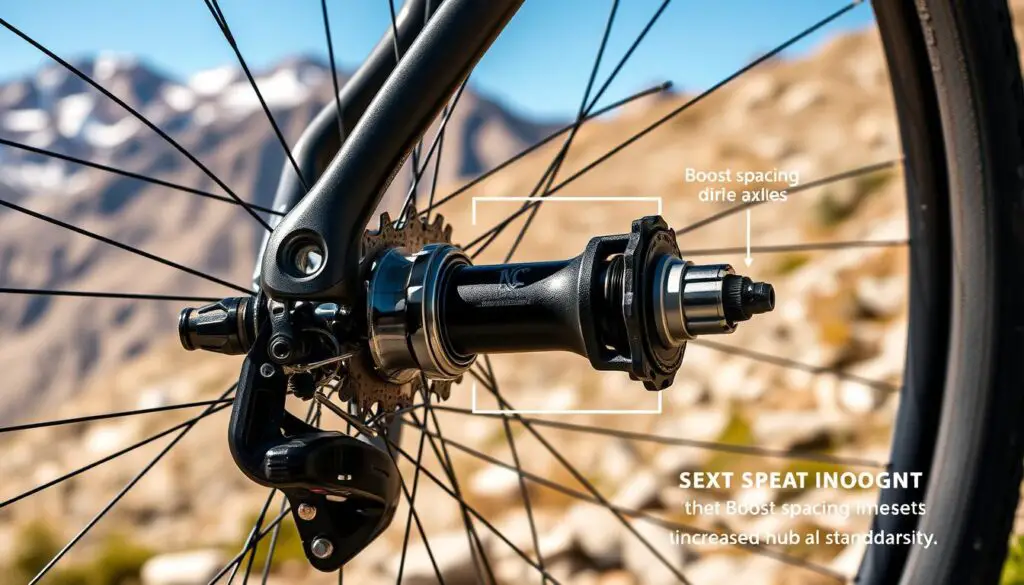
Boost spacing has its ups and downs. It makes bikes stiffer and stronger but can cause problems with some parts. Knowing about front and rear hub specs and chainline is key.
The Boost 148 standard changed the game in 2015. It made rear hubs wider, giving more options for chainrings. Boost adds 6mm to the rear and 10mm to the front hub. This makes bikes stiffer and stronger.
Front Hub Boost Specifications
Front hub specs are vital for bike performance. Boost 110 makes hubs 5mm wider on each side. This boosts stiffness and helps with fork clearance.
Rear Hub Boost Specifications
Rear hub specs are also crucial. Boost 148 makes rear hubs wider for more stiffness and strength. This improves wheel strength and bracing angles.
Boost spacing is key for bike performance and compatibility. Understanding hub specs and chainline helps riders choose the right bike parts. This affects the bike’s performance and compatibility.
How Boost Spacing Affects Wheel Strength
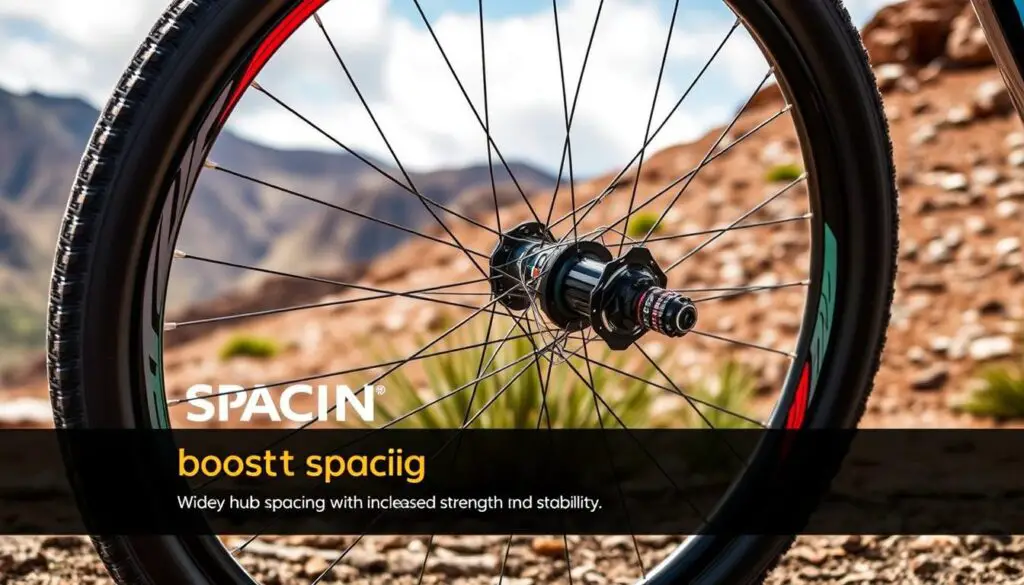
Boost spacing makes a big difference in a wheel’s strength and durability. It widens the rear axle to 148mm and the front to 110mm. This makes the wheels more stable and rigid, boosting the bike’s performance.
The mtb hub boost spacing also changes the spoke angles. This makes the wheel stronger and more durable. It’s great for riders who do aggressive or high-impact riding.
Impact on Spoke Angles
Boost spacing spreads stress evenly across the spokes. This makes the wheel stronger and more durable. It’s very helpful for riders with larger wheels, as it adds extra support and stability.
Structural Benefits for Larger Wheels
Boost spacing in larger wheels brings several benefits. It increases stiffness and stability. The wider axles and even spoke angles create a stronger wheel. This means better performance and handling, even at high speeds or in tough terrain.
Boost spacing in mtb hub design greatly affects wheel strength and durability. It provides a stable and rigid platform for the wheels. This boosts the bike’s performance and handling, making it key for serious riders.
Key Benefits of Boost Spacing Technology
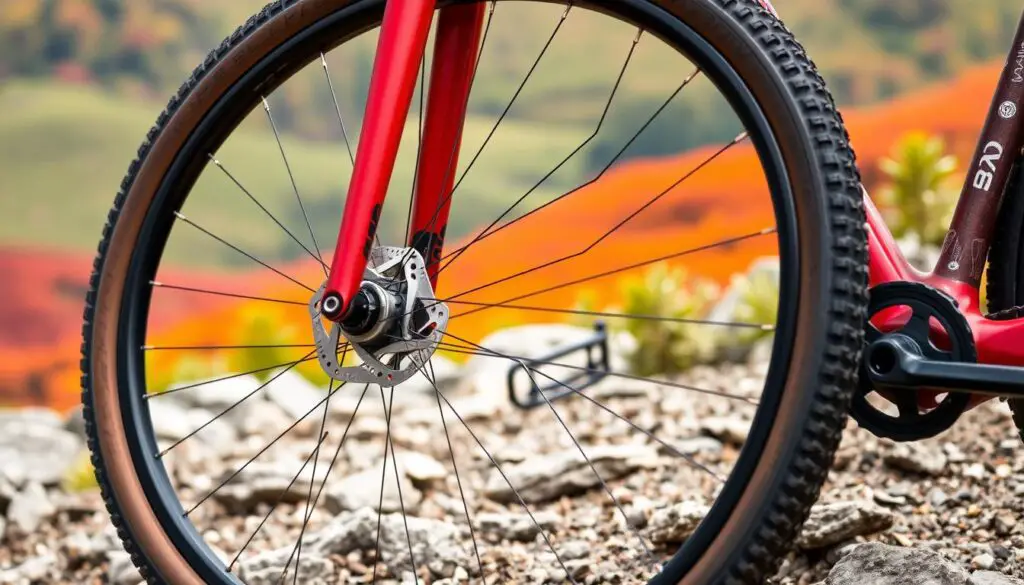
The boost spacing technology brings many benefits. It makes wheels stiffer and more durable. This wider rear hub setup gives a ride that’s more stable and confident.
The boost spacing benefits also include better steering and geometry for short frames. Plus, it offers more choices in chain rings.
Some of the key boost spacing advantages include:
- Improved lateral stiffness, resulting in a 20% increase for 29″ wheels and 14% for 27.5″ wheels
- Increased tire travel, allowing for wider tire sections and improved traction
- Enhanced wheel durability, resulting in a more stable and confident ride
Overall, the boost spacing benefits make it a great choice for mountain bikers. It boosts stiffness, durability, and efficiency, making it perfect for high-performance rides.
The following table summarizes the key benefits of boost spacing technology:
| Benefit | Description |
|---|---|
| Improved Lateral Stiffness | 20% increase for 29″ wheels, 14% for 27.5″ wheels |
| Increased Tire Travel | Allowing for wider tire sections and improved traction |
| Enhanced Wheel Durability | Resulting in a more stable and confident ride |
Potential Drawbacks and Limitations
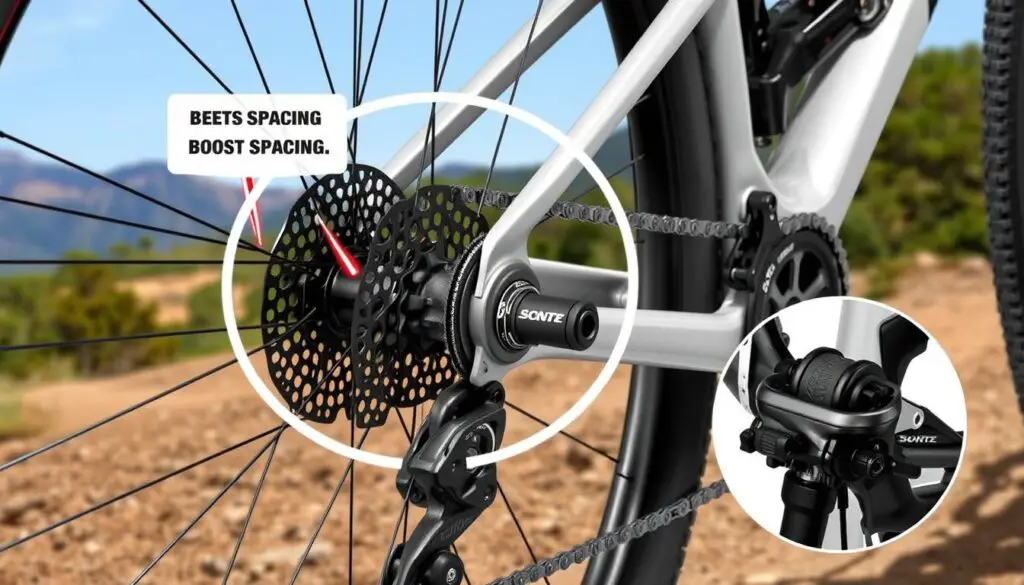
Boost spacing has many benefits, but it also has some downsides. One big boost spacing disadvantage is the cost. The bigger hub shells and longer axle can make things more expensive. This might mean higher prices for buyers.
Another issue is making sure all parts work together. This can be tough, mainly for those with older, non-boost parts.
Some key limitations of boost spacing include:
- Higher cost of production and potential increased cost to consumers
- Compatibility issues with existing non-boost compatible components
- Potential weight considerations due to the increased axle diameter and wider hub shells
Even with these challenges, many bike makers now use boost spacing. But, riders should think about these boost spacing disadvantages and check if their parts fit before buying.
In summary, boost spacing has its pluses, but we must also look at the downsides. These include higher costs, compatibility problems, and weight issues.
| Component | Boost Spacing Compatibility | Cost Implications |
|---|---|---|
| Wheels | Yes | Higher cost of production |
| Frames | Yes | Higher cost of production |
| Hub Shells | Yes | Higher cost of production |
Boost vs. Super Boost: Understanding the Differences
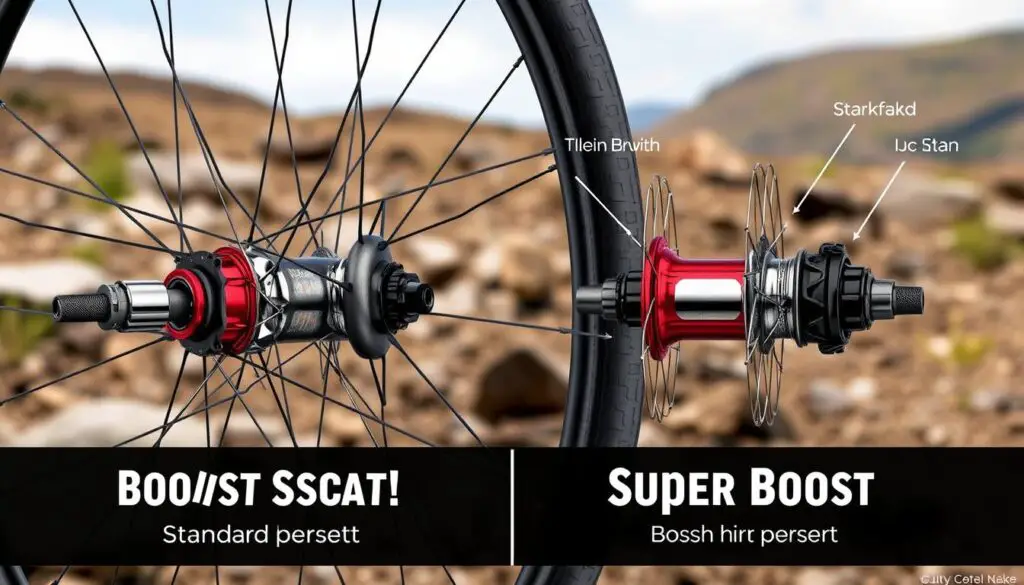
In mountain biking, mtb hub boost spacing comes in two main types: Boost and Super Boost. Both offer better stability and stiffness than traditional quick-release hubs. Boost spacing in mountain biking is gaining popularity for its ability to fit wider tires and strengthen wheels.
Super Boost has a wider hub spacing than Boost. This wider spacing gives more room for wider tires and better stiffness. Yet, Super Boost is less common than Boost and is mostly found in high-end bikes. Super Boost frames have a 56 mm chain line, while Boost frames have 52 mm.
Here are some key differences between Boost and Super Boost:
- Hub spacing width: Super Boost is wider than Boost
- Clearance for wider tires: Super Boost offers more clearance than Boost
- Lateral stiffness: Super Boost offers improved lateral stiffness compared to Boost
- Chain line: Super Boost has a wider chain line than Boost
When it comes to compatibility, Enduro Boost 148 doesn’t convert to Super Boost Plus. Converting Downhill 150 mm hubs to Super Boost Plus is possible but not ideal. Mountain bikers should think about their bike’s intended use and the terrain they’ll ride on. Knowing the differences between Boost and Super Boost helps riders make the right choice for their needs.
| Hub Spacing Standard | Width | Clearance for Wider Tires | Lateral Stiffness |
|---|---|---|---|
| Boost | 148 mm | Improved | Good |
| Super Boost | 157 mm | Even more clearance | Improved |
Converting Non-Boost Frames to Boost Standard
Riders wanting to upgrade their non-boost frames to the latest boost standard have several options. The conversion process is easy, thanks to various components and kits available. It’s important to consider boost spacing compatibility to ensure the frame works well with other boost-standard parts.
Choosing the right components is key. This includes boost-specific cranks, chainrings, and hubs. The boost spacing benefits include better wheel stiffness and improved chainline. Riders can use kits like the Woolftooth Boostinator or the MT Zoom front Boost adapter to get these benefits without adding much weight.
The cost of conversion varies, offering options for all budgets. The Boost Hub Spacer Kit is a budget-friendly choice, starting at £10.95 for the front kit and £13.95 for the rear. Brands like Hope Tech and Spank Industries also offer adapters and conversion options, helping riders find the perfect solution.
Conversion Methods
- Using a boost-specific hub or conversion kit
- Installing boost-compatible cranks and chainrings
- Adding spacers to the existing hub to achieve the correct boost spacing
Understanding how to convert non-boost frames to boost standard allows riders to enjoy the boost spacing benefits. They get improved performance and better compatibility with the latest components.
Boost Spacing’s Impact on Different MTB Disciplines
Boost spacing is now common in many mountain bikes. This includes cross-country, downhill, and enduro bikes. It makes the ride stable and confident, fitting well for various MTB disciplines.
Boost spacing changes how bikes handle and perform. For instance, the Chromag Lowdown bike has boost spacing. This makes it stable and confident, fitting well for different MTB disciplines. Some benefits include:
- Improved stability and confidence
- Enhanced handling and performance
- Increased compatibility with modern mountain bike components
There are also things to consider with boost spacing in different MTB disciplines. For example, the rise of e-bikes is a big change. Santa Cruz Bikes sees this as a significant shift, which might change how boost spacing is used.
Boost spacing is now a standard in many modern mountain bikes. Its impact on different MTB disciplines is big. As the mountain bike world keeps evolving, it will be exciting to see how boost spacing and other techs shape mountain biking’s future.
| MTB Discipline | Boost Spacing Benefits |
|---|---|
| Cross-Country | Improved stability and confidence |
| Downhill | Enhanced handling and performance |
| Enduro | Increased compatibility with modern mountain bike components |
Future Trends in MTB Hub Standards
The mountain biking world is always changing. New tech and standards pop up every year. Boost spacing in mountain biking has become a big deal. It makes bikes perform better and stay stable.
As we look ahead, we’ll see more improvements in boost spacing. Some makers are working on 20mm Boost, which is even stiffer. This trend will keep going, with more brands using the new standard and creating cool products.
The new standards bring many benefits. They make wheels stronger, stiffer, and work better with other parts. For example, 20mm Boost has bigger brake mounts. This makes it easier to put on and take off wheels. Plus, it works with 15mm Boost wheels, so you can upgrade without changing your whole wheelset.
New tech is coming in hub design, materials, and how they’re made. Some use carbon fiber and titanium for lighter, stronger hubs. Others are using 3D printing for unique hub designs.
The future of mtb hub boost spacing is exciting. With new tech and standards always coming, we’ll see even better bikes. They’ll perform better, be more stable, and work well with other parts.
Conclusion
The benefits of boost spacing in mountain biking are many. Boost spacing benefits include stronger wheels and better handling. The mtb hub boost spacing standard is now common, with a front hub width of 110 x 15 and a rear hub spacing of 148 x 12.
This setup makes bikes stiffer and more stable. It’s perfect for mountain bikes with wider tires.
Manufacturers say the boost spacing benefits are clear. 29″ rear wheels with 148mm hubs are as stiff as 27.5″ wheels with 142mm hubs. The wider hub flanges of mtb hub boost spacing wheels also add to the bike’s stability.
Boost also lets for shorter chainstays without losing tire clearance. This makes bikes more agile and allows for bigger chainrings.
In short, the move to boost spacing benefits and mtb hub boost spacing has changed mountain biking. It has brought better performance, stability, and handling. As the sport grows, boost spacing benefits will likely stay a key part of mountain bike design. This will give riders a more confident and fun ride.

I am Ryan Ford, a mountain biking enthusiast who loves to explore the outdoors. I also like to go on adventures with friends and anything else that involves being outside. I love my bike because it gets me out of the house and gives me an opportunity to enjoy nature.

